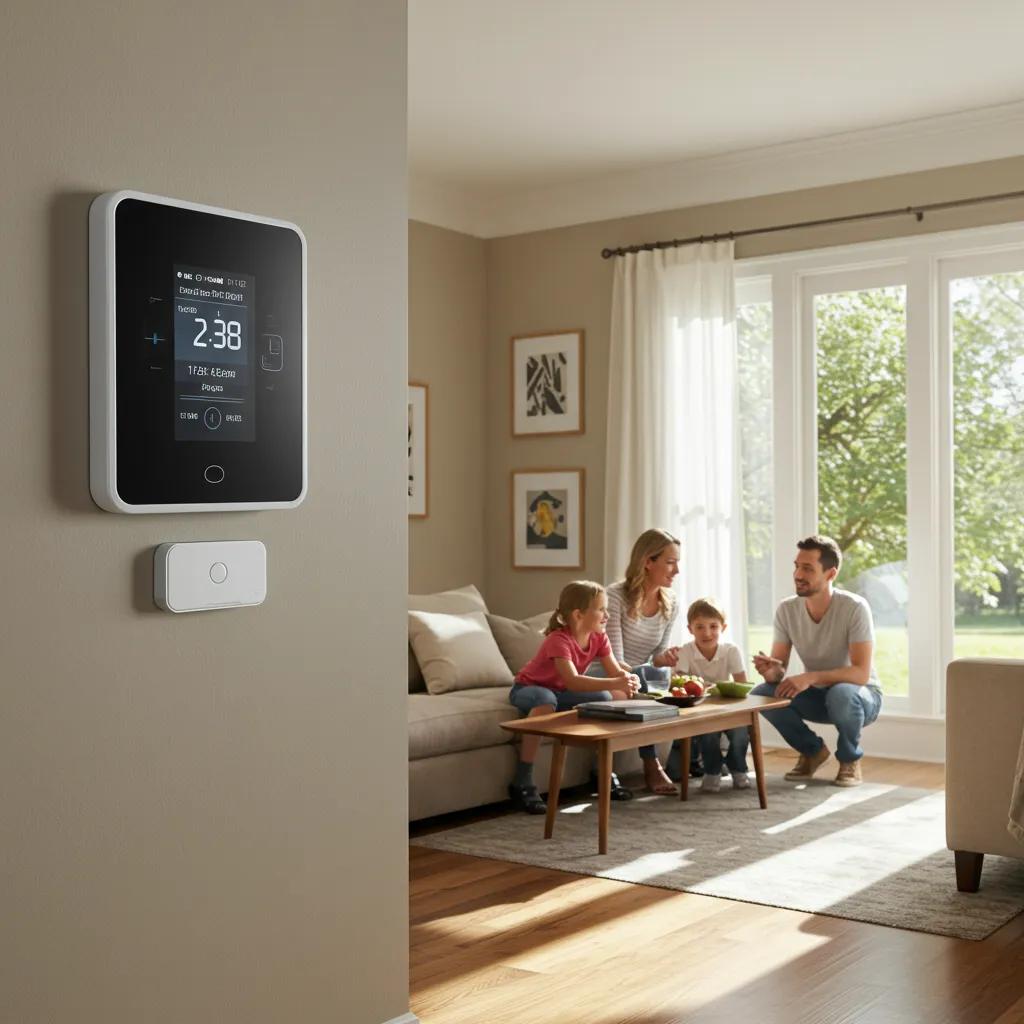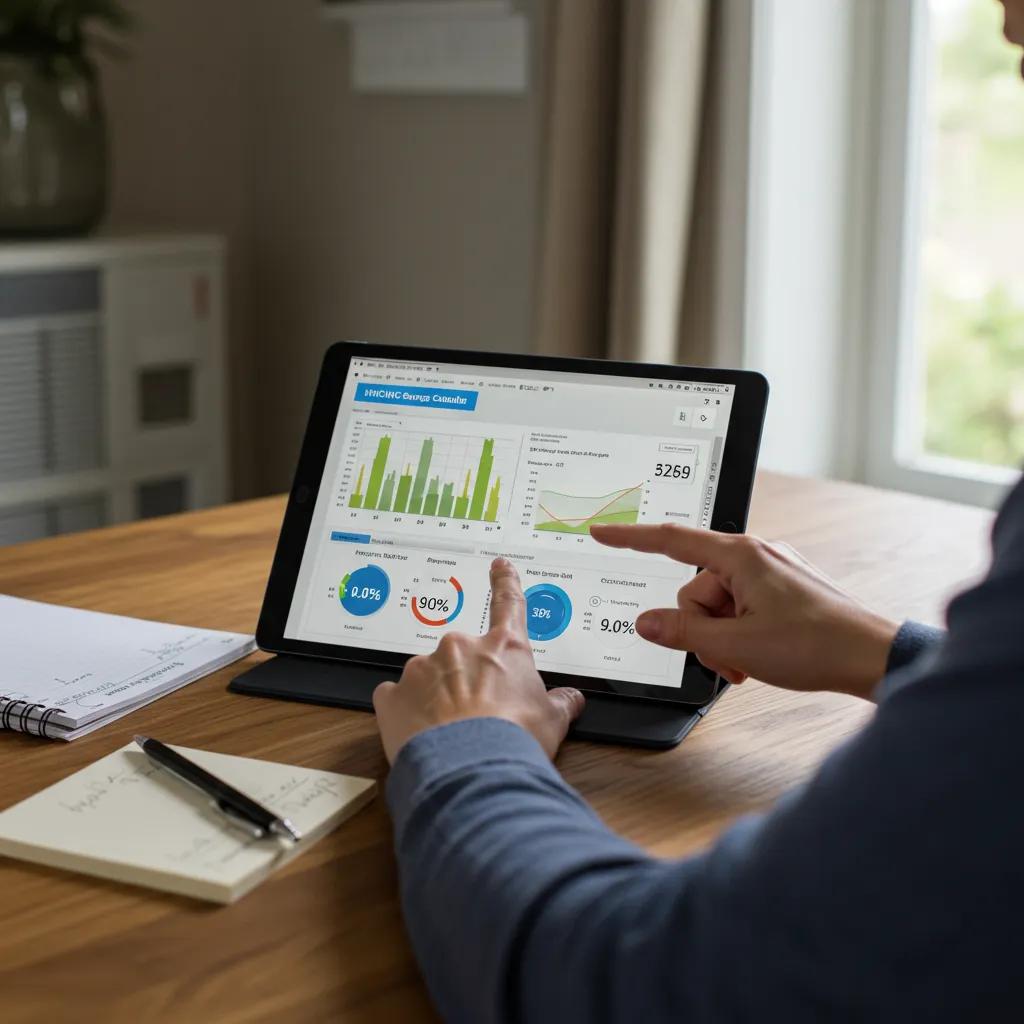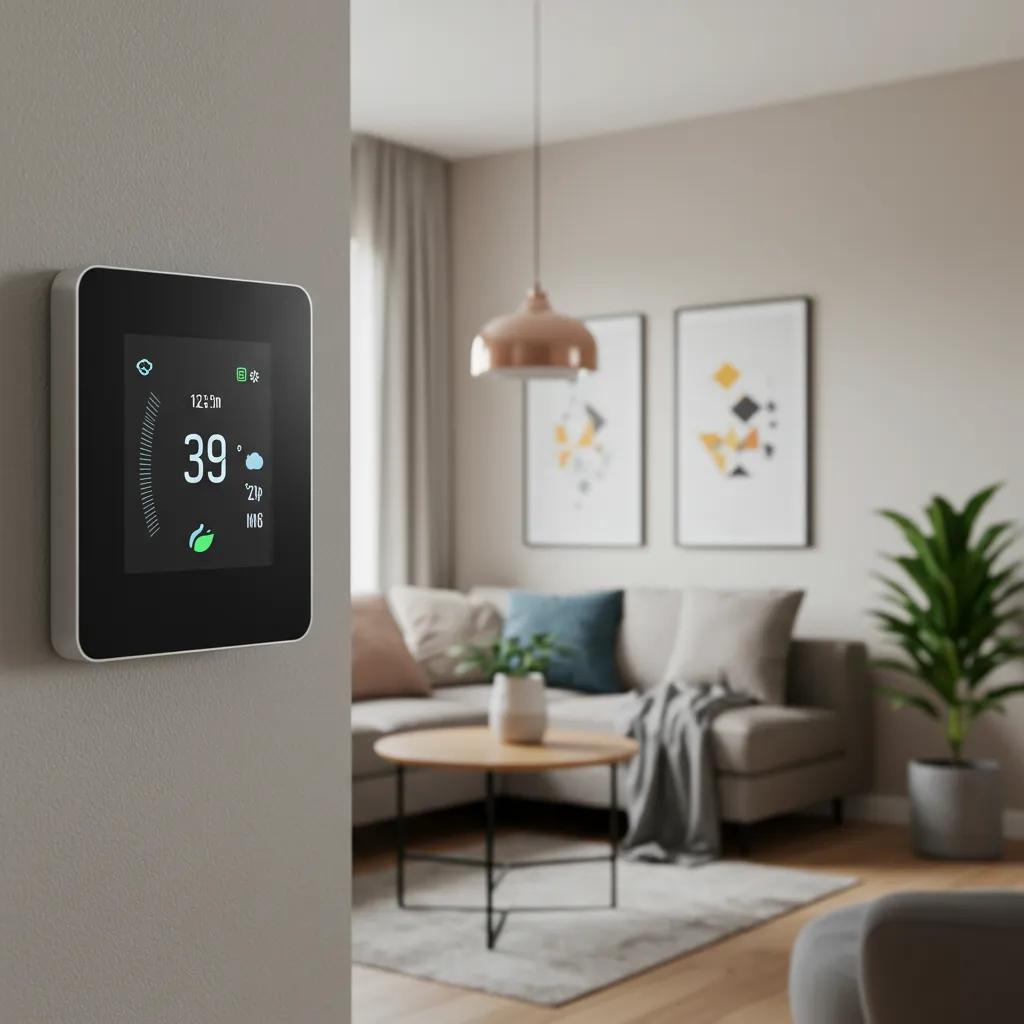
Slash Energy Bills with an HVAC Savings Calculator
Upgrading to an energy-efficient HVAC system can significantly reduce heating and cooling costs, transforming your utility bills into manageable monthly expenses. Homeowners in Northwest Indiana often face high energy use during frigid winters and humid summers, but precise savings estimates and targeted upgrades deliver immediate relief and lasting value. In this guide, you’ll discover how an HVAC savings calculator works, compare top-performing heating and cooling solutions, explore smart thermostat benefits, prioritize maintenance steps, uncover the power of home energy audits, leverage local rebates, and link efficiency improvements to enhanced comfort and resale value. With actionable insights and expert tips, you’ll gain confidence in calculating your HVAC savings and making cost-effective decisions.
How Can an HVAC Energy Efficiency Calculator Help You Save on Heating and Cooling?

An HVAC energy efficiency calculator estimates potential savings by comparing your existing system’s performance with high-efficiency alternatives, helping you improve energy use and reduce utility bills. By inputting key data points, you receive an immediate projection of annual cost reductions and payback periods, guiding investment in energy-efficient heating and cooling.
Here are the primary benefits of using an HVAC savings calculator:
- Instant savings estimates based on local energy rates and system efficiency.
- Comparison of SEER and AFUE ratings to quantify performance improvements.
- Identification of the most cost-effective upgrade path for your home.
- Clear payback period to prioritize budgets and financing decisions.
- Actionable insights to schedule professional consultations and free estimates.
These advantages empower homeowners to make informed decisions and lay the groundwork for selecting the right HVAC solution.
What Inputs Do You Need for an Accurate HVAC Savings Estimate?
An accurate HVAC savings estimate requires current and projected data that reflect your home’s usage and equipment performance. Essential inputs include:
- Current SEER (Seasonal Energy Efficiency Ratio) or AFUE (Annual Fuel Utilization Efficiency) rating of your existing system.
- Projected SEER and AFUE ratings for the new equipment you’re considering.
- Average local electricity and fuel rates in Porter and Lake Counties.
- Annual heating and cooling hours based on regional weather patterns.
- Home size in square feet and insulation quality to adjust load calculations.
These inputs ensure the savings calculator captures the true energy consumption profile of your property and projects realistic cost reductions.
How Do SEER and AFUE Ratings Impact Your Energy Bills?
SEER and AFUE ratings measure how efficiently an HVAC system converts energy into cooling or heat, directly influencing your monthly expenses. A higher SEER rating indicates greater cooling efficiency, while a higher AFUE percentage reflects more effective fuel use in furnaces.
| Rating Type | System Function | Efficiency Benefit |
|---|---|---|
| SEER | Air conditioner output | Delivers up to 40% more cooling per kWh |
| AFUE | Furnace heat output | Converts 90–98% of fuel into useful heat |
Understanding SEER and AFUE Ratings for HVAC Energy Efficiency
Higher Seasonal Energy Efficiency Ratio (SEER) ratings for air conditioners and Annual Fuel Utilization Efficiency (AFUE) ratings for furnaces indicate greater energy efficiency, leading to significant reductions in utility bills. Upgrading from a 13 SEER system to a 16 SEER system can result in up to 30% energy savings, while a 95% AFUE furnace is considerably more efficient than an 80% AFUE unit, saving thousands over its lifespan.
This research supports the article’s claims about how SEER and AFUE ratings directly impact energy bills and the potential savings from upgrading to higher-efficiency HVAC systems.
What Are Typical Energy Savings for Upgrading HVAC Systems in Northwest Indiana?
Local climate and energy costs shape realistic savings for Porter and Lake County homeowners when upgrading to ENERGY STAR-certified systems. Average annual reductions include:
- 20–30% lower heating bills with a 95% AFUE furnace replacing a 60% unit.
- 25–40% lower cooling bills with a 16+ SEER air conditioner versus an 8 SEER model.
- Up to 35% combined savings with a modern heat pump replacing an aging split system.
These projections account for regional temperature swings and local utility rates, offering homeowners clear expectations when planning upgrades.
How to Interpret Your HVAC Savings Calculator Results?
Calculator output typically shows annual cost savings, percentage reduction, and payback period. To interpret results:
- Review the annual savings figure to gauge immediate impact on your utility budget.
- Examine the percentage reduction to compare system performance improvements.
- Note the payback period to understand when your investment breaks even.
- Align figures with your home’s comfort goals and financing options.
Armed with this data, you can schedule a free estimate with certified technicians who will refine calculations and tailor solutions to your property.
What Are the Best Energy-Efficient HVAC Systems to Maximize Your Savings?
Energy-efficient HVAC systems integrate advanced heat exchange technologies and variable-speed components to enhance performance and trim energy use. Investing in high-efficiency furnaces, air conditioners with superior SEER ratings, and modern heat pumps boosts savings while ensuring consistent indoor comfort.
The top system types include:
- High-Efficiency Furnaces – Optimize fuel combustion to achieve 95–98% AFUE.
- High-SEER Air Conditioners – Offer SEER ratings of 16–26 for peak cooling efficiency.
- Modern Heat Pumps – Provide year-round climate control with efficiency up to 30% better than traditional systems.
These options deliver substantial reductions in utility costs and support long-term home value.
How Do High-Efficiency Furnaces Reduce Heating Costs?
High-efficiency furnaces improve heat transfer by capturing more of the combustion energy, thus reducing fuel waste. With sealed combustion chambers and variable-speed blowers, these furnaces maintain stable temperatures and minimize on/off cycling. As a result, homeowners see 25–35% lower heating bills compared to standard models.
What SEER Ratings Should You Look for in Air Conditioners?
Aim for a minimum SEER rating of 16 to secure significant cooling efficiency gains. Units rated 20 and above deliver premium performance, cutting energy use by up to 40% compared to basic 13 SEER models. Higher SEER ratings also support smoother temperature regulation and quieter operation.
How Can Heat Pumps Save You Money on Year-Round Heating and Cooling?
Heat pumps transfer heat rather than generating it, using electricity more efficiently than traditional furnaces in moderate climates. In Northwest Indiana, cold-climate heat pumps maintain ample heating capacity down to –10°F while providing energy-efficient cooling in summer. Homeowners can anticipate 20–30% lower combined heating and cooling costs.
Which HVAC Brands Offer the Best Energy Savings in Northwest Indiana?
| Brand | Key Efficiency Feature | Typical Rating Range |
|---|---|---|
| York | Variable-speed compressors | 16–26 SEER, 95–98% AFUE |
| Guardian | High-output heat exchangers | 17–24 SEER, 95% AFUE |
| Bosch | Inverter-driven heat pumps | 18–20 SEER, 9.0 HSPF (heating) |
Selecting a reputable brand establishes a strong foundation for maximized energy savings and dependable performance.
How Do Smart Thermostats Contribute to Home Heating and Cooling Savings?

Smart thermostats leverage adaptive algorithms and remote control to optimize scheduling, reducing unnecessary runtime and supporting energy-efficient operation. By adjusting setpoints automatically based on occupancy patterns and weather forecasts, these devices boost savings without sacrificing comfort.
Key contributions include:
- Learning household routines and pre-conditioning spaces for optimal efficiency.
- Enabling remote temperature adjustments to prevent energy waste during absences.
- Integrating with HVAC diagnostics to alert homeowners about system inefficiencies.
This intelligence drives up to 10% annual savings on heating and cooling bills.
Smart Thermostat Energy Savings in Indiana
Studies conducted in Indiana have shown that smart thermostats, such as Nest devices, can significantly reduce residential energy consumption. Evaluations found average reductions of 13.3% in heating gas consumption and 14.5% in cooling electricity usage.
This directly verifies the article’s claim that smart thermostats contribute to annual savings on heating and cooling bills, specifically referencing studies within Indiana.
What Are the Top Smart Thermostats for Indiana’s Climate?
Local conditions demand reliable performance in temperature extremes and humidity. Top choices feature:
- Adaptive learning for winter pre-heat and summer pre-cool cycles.
- Weather-integrated forecasting to fine-tune setpoints.
- Geofencing to reduce runtime when residents are away.
These capabilities ensure balanced comfort and energy conservation throughout Indiana’s seasonal swings.
How Does Smart Thermostat Installation Improve HVAC Efficiency?
Professional installation positions sensors and thermostats for accurate readings and seamless integration with ductwork, enabling precise control. Correct wiring and calibration protect system components, promote steady cycling, and prevent overheating or pressure imbalances.
Can Smart Thermostats Really Lower Your Utility Bills?
Yes, smart thermostats learn occupancy patterns and adjust temperatures automatically, delivering up to 10% savings on annual heating and cooling costs. Their adaptive scheduling reduces runtime during peak energy periods and prevents unnecessary system operation.
Why Is Regular HVAC Maintenance Essential for Lower Energy Bills?
Routine HVAC maintenance preserves system efficiency, supports consistent performance, and prevents energy loss due to wear and tear. By addressing minor issues before they escalate, maintenance extends equipment lifespan and sustains optimal energy use.
Continue with targeted maintenance ensures sustained savings and sets the stage for strategic upgrades.
How Does Annual Furnace Tune-Up Improve Energy Efficiency?
A professional furnace tune-up cleans burners, inspects heat exchangers, and calibrates controls to restore design-level performance. Proper airflow and combustion adjustment reduce fuel waste by 5–10% and prevent costly breakdowns.
What Is the AC Maintenance Checklist for Optimal Cooling Savings?
Ensuring peak air conditioner efficiency involves:
- Cleaning or replacing coils and fins.
- Checking refrigerant pressure and leak integrity.
- Verifying fan motor function and belt tension.
- Inspecting condensate drainage to prevent blockages.
Regular attention keeps cooling capacity at peak levels and avoids energy spikes.
How Often Should You Replace Air Filters to Save Energy?
Replacing standard filters every 30–60 days and pleated filters every 90 days prevents airflow restrictions. Clean filters reduce blower energy use by up to 15% and support healthy indoor air quality.
What Does a Home Energy Audit Reveal About Your HVAC Savings Potential?
A professional home energy audit identifies inefficiencies in insulation, air sealing, and system performance, mapping how and where energy escapes. By pinpointing waste sources, audits guide targeted improvements that enhance HVAC efficiency and lower utility costs.
These insights build a roadmap for effective savings measures and system upgrades.
What Happens During a Professional HVAC Energy Audit?
An auditor examines ductwork integrity, insulation levels, and equipment operation using blower door tests and infrared imaging. Detailed analysis quantifies heat loss and uncovers hidden leaks, producing a comprehensive report with upgrade recommendations.
How Can Identifying Air Leaks and Poor Insulation Reduce Your Bills?
Sealing gaps around windows, doors, and duct joints prevents conditioned air from escaping, reducing heating and cooling demands by up to 20%. Enhanced insulation limits thermal transfer through walls and attics, cutting energy use by 10–15%.
When Should Northwest Indiana Homeowners Schedule an Energy Audit?
Homeowners typically benefit from audits in late summer or early fall, allowing time to implement insulation and duct sealing before winter’s peak heating season. Early scheduling also ensures eligibility for seasonal rebate programs and free estimate offers.
Which Local HVAC Rebates and Incentives Can Boost Your Upgrade Savings?
Federal and state incentives reduce upfront costs for energy-efficient HVAC installations, maximizing your return on investment. By combining tax credits, utility rebates, and manufacturer promotions, homeowners can recover a significant portion of upgrade expenses.
A proactive rebate strategy amplifies long-term savings and accelerates payback.
What Federal Tax Credits Are Available for Energy-Efficient HVAC Systems?
The Inflation Reduction Act offers up to $3,200 in federal tax credits for qualifying heat pumps, furnaces, and air conditioners that meet ENERGY STAR criteria. These credits directly lower your tax liability in the year of installation.
What Indiana State and Utility Rebates Can You Claim in Porter and Lake Counties?
Local utilities provide tiered rebates, such as $300–$1,200 for high-efficiency furnaces and $200–$800 for ENERGY STAR air conditioners. State energy offices may offer additional grants or on-bill financing to reduce initial purchase costs.
Federal and Indiana Incentives for Energy-Efficient HVAC Upgrades
The Inflation Reduction Act of 2022 provides federal tax credits for energy-efficient home improvements, including HVAC systems. Homeowners can claim up to 30% of project costs, with an annual limit of $1,200 for general improvements and a separate $2,000 limit for heat pumps, totaling up to $3,200 annually. Additionally, Indiana utility companies like AES Indiana, Duke Energy, and CenterPoint Energy offer various rebates for qualifying high-efficiency HVAC installations.
This citation confirms the federal tax credits and provides examples of local utility rebates available in Indiana, supporting the article’s section on leveraging incentives.
How Do Rebates Affect Your Overall HVAC Upgrade Cost Savings?
Combining federal credits, state incentives, and utility rebates can cover 20–30% of equipment and installation costs, lowering net expenses and shortening payback periods by several years.
How Can You Maximize Your HVAC Savings While Improving Home Comfort and Value?
Enhancing energy efficiency not only reduces utility bills but also promotes balanced indoor temperatures, cleaner air, and increased property appeal. Strategic upgrades align comfort goals with financial benefits, ensuring higher resale value and occupant well-being.
Optimized energy performance and improved home environments create lasting returns and market differentiation.
How Does Energy Efficiency Improve Indoor Air Quality and Temperature Consistency?
Efficient systems maintain steady airflow and filtration, removing airborne contaminants and balancing humidity. Consistent temperatures eliminate hot and cold spots, delivering healthier, more comfortable living spaces.
Can Upgrading Your HVAC System Increase Your Home’s Resale Value?
Energy-efficient HVAC installations command higher buyer interest, often adding 5–10% to a home’s market price. Certified ENERGY STAR systems provide verifiable performance benefits that enhance curb appeal and long-term investment potential.
What Financing Options Make Energy-Efficient HVAC Upgrades Affordable?
Flexible financing plans, including zero-interest loans and on-bill repayment programs, spread upgrade costs over time without denting monthly budgets. Many local providers offer specialized financing that aligns payments with projected energy savings.
A strategic financing approach ensures upgrades are both accessible and cost-effective, supporting immediate and future savings.
Upgrading your HVAC system with energy-efficient equipment, precise savings calculations, smart controls, and targeted maintenance empowers you to lower utility bills, elevate home comfort, and boost property value. By leveraging local rebates and financing options, you can achieve rapid payback and long-term performance. Start calculating your personalized HVAC savings today and transform your home into an efficient, comfortable, and valuable asset.